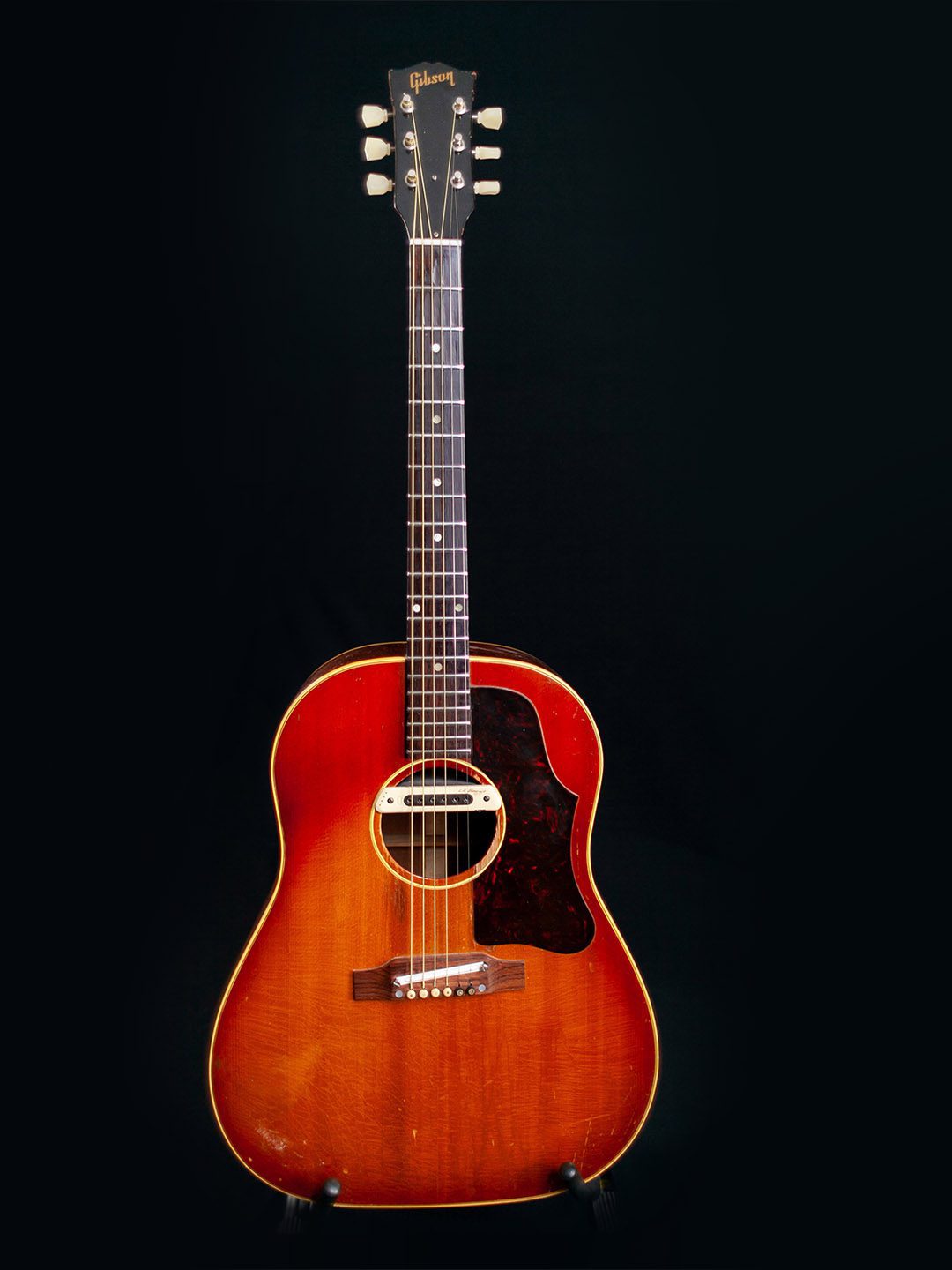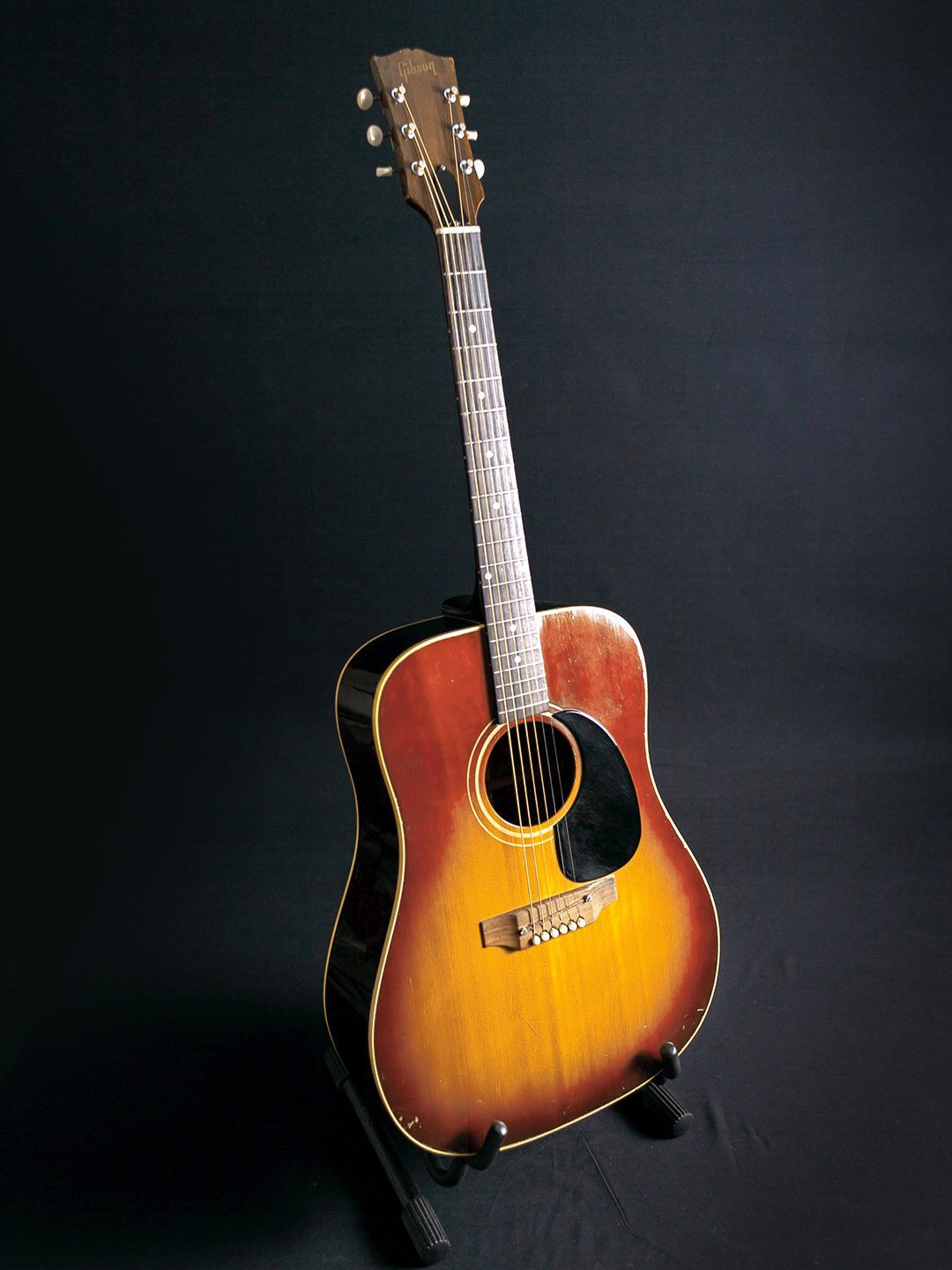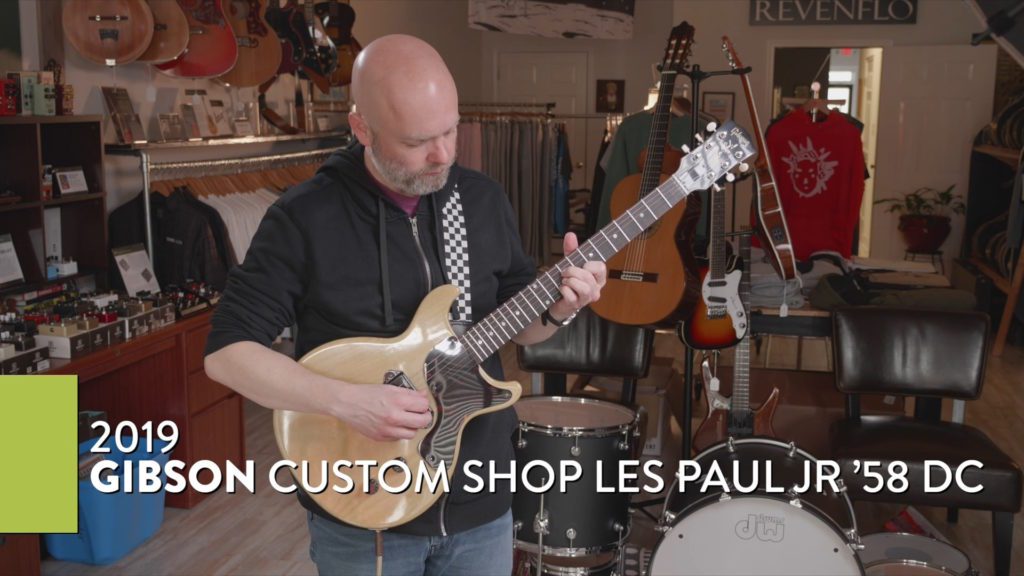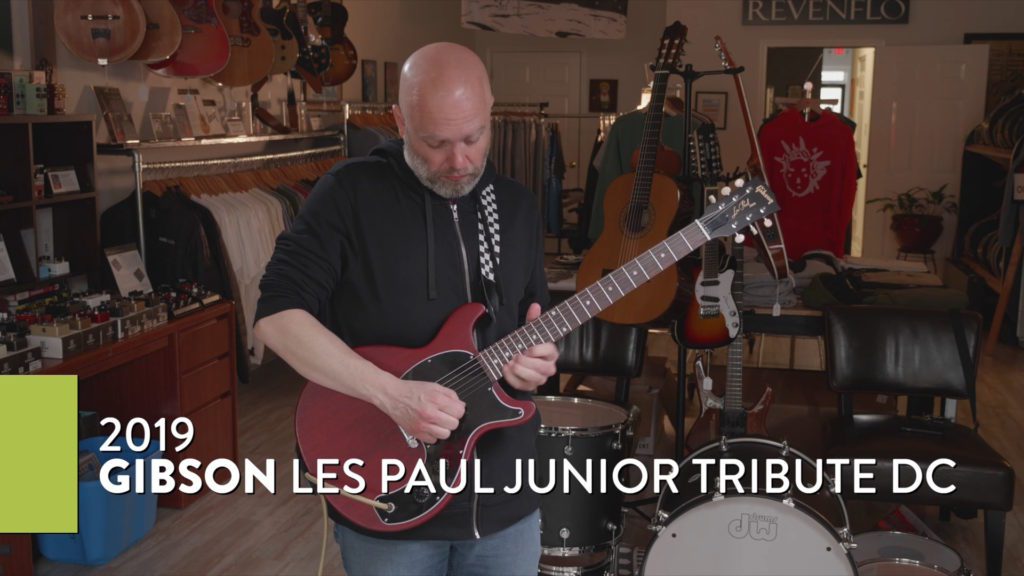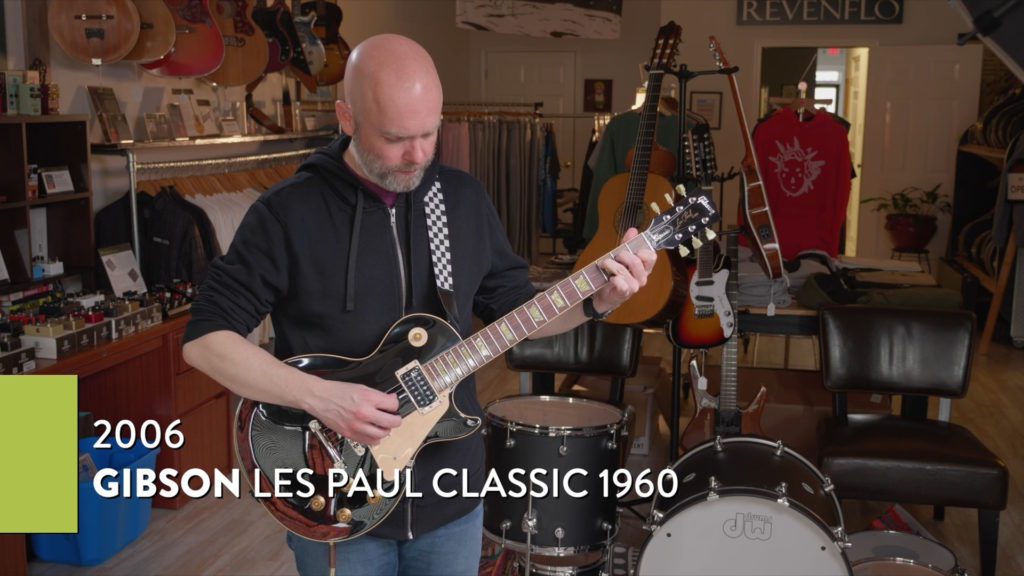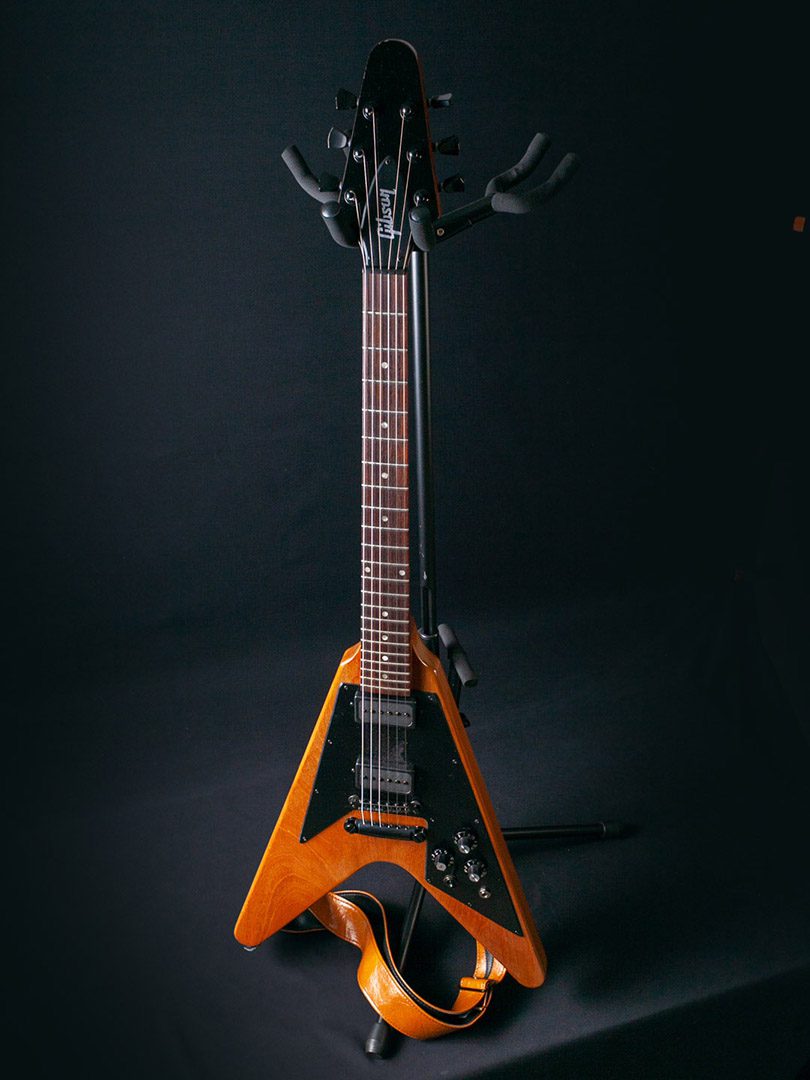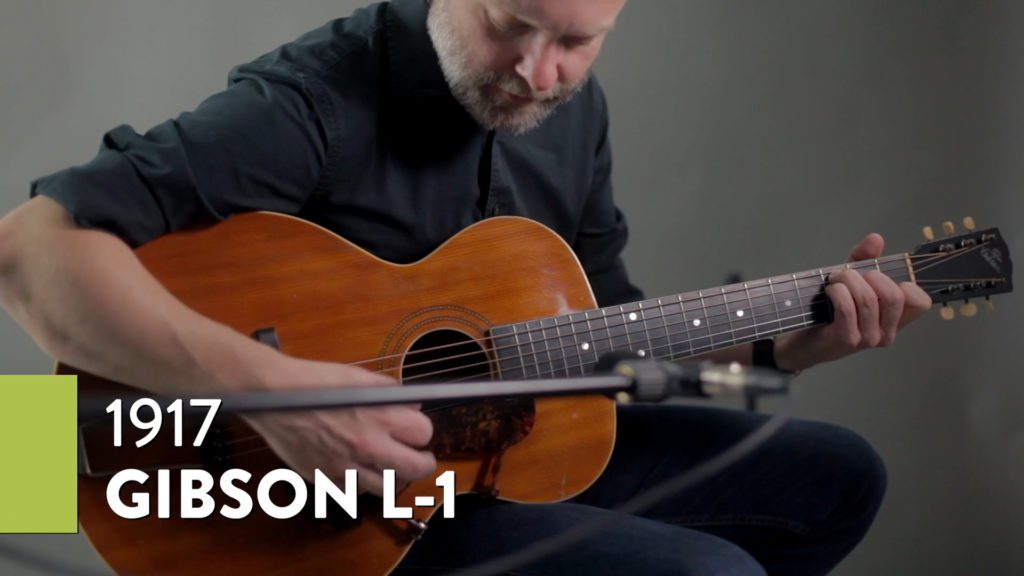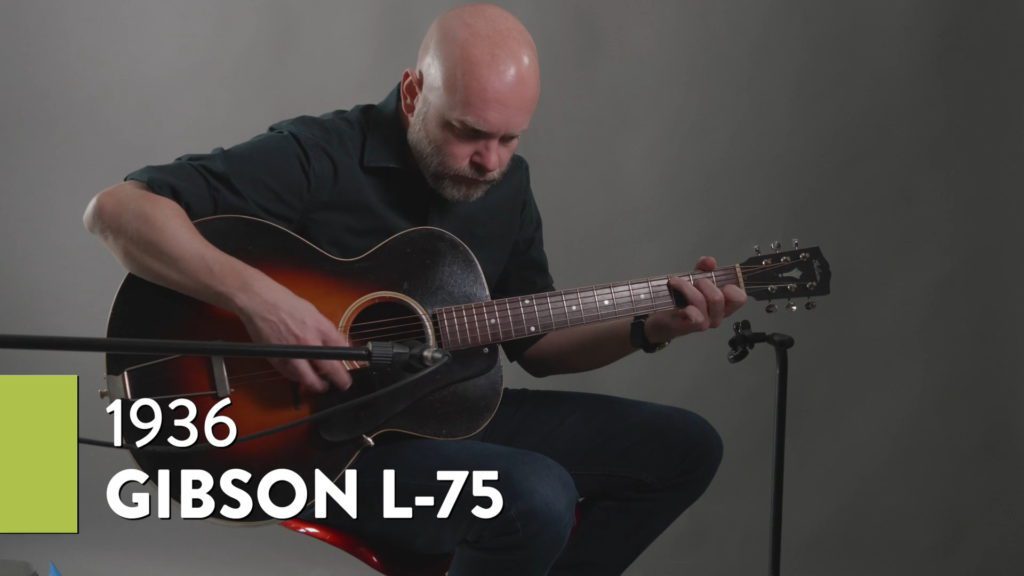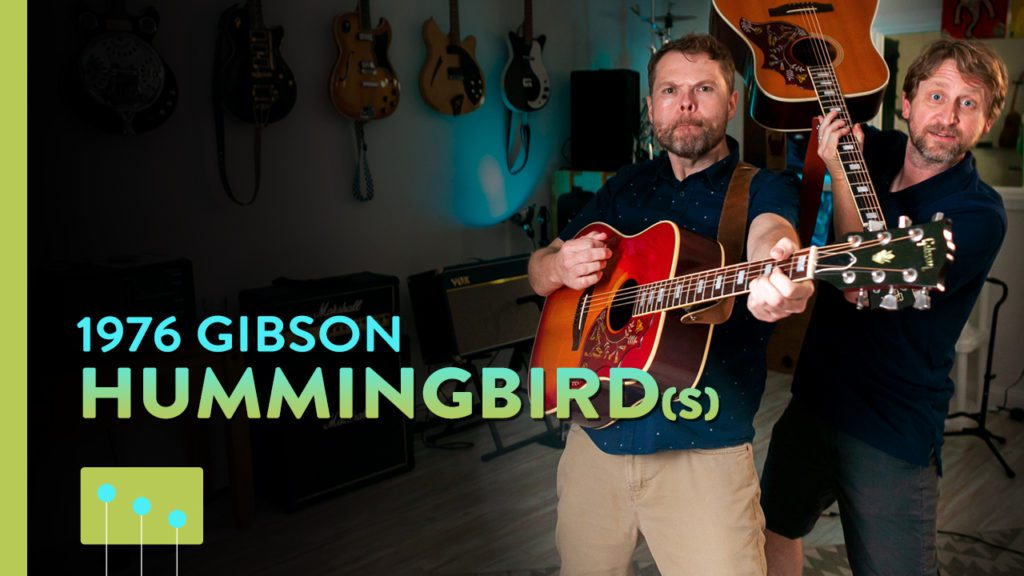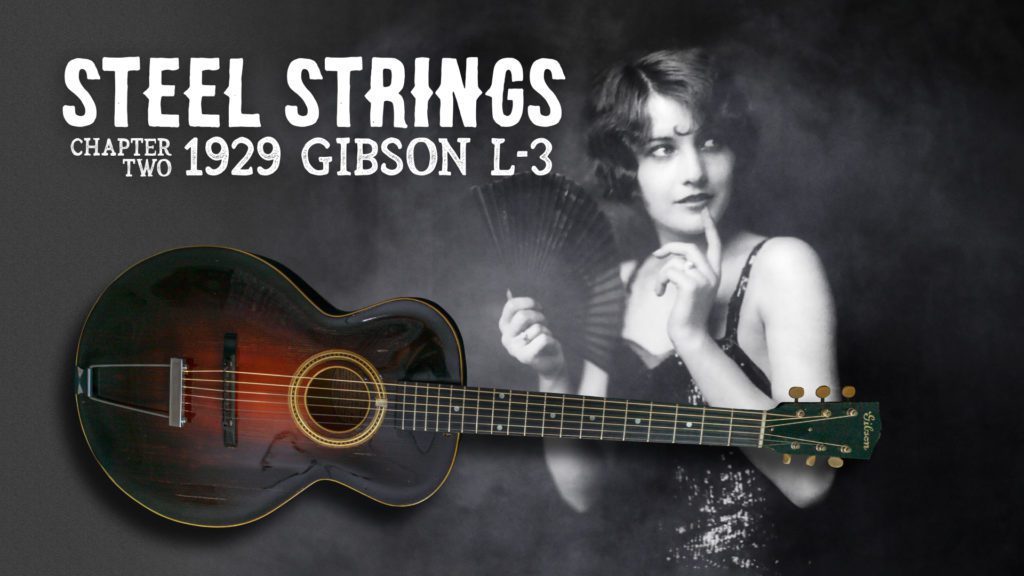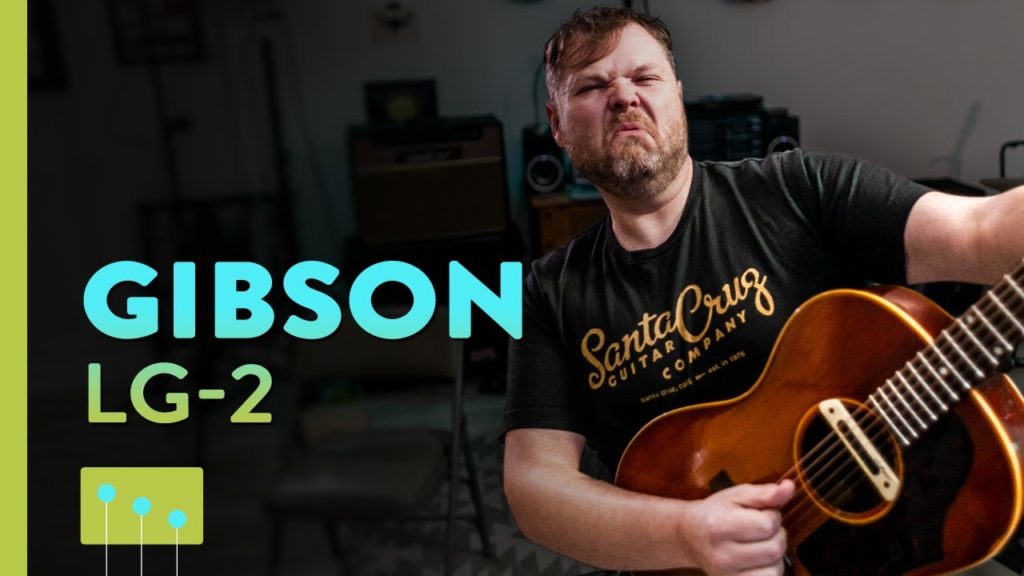Gibson Acoustic Guitars

Gibson Acoustic Guitars
Gibson is one of the biggest guitar makers in the world and one of the most well-respected brands in guitar making. Vintage Gibson Acoustic Guitars are high quality, sought after, and iconic.
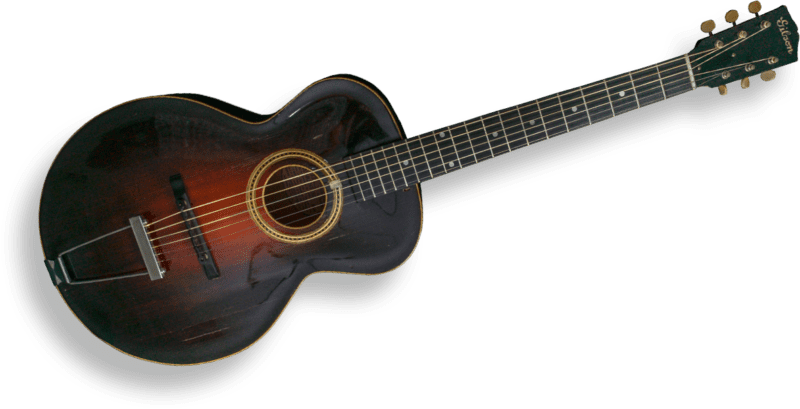
From Garage to Giant
In the 1890s, Orville Gibson built instruments in his home workshop in Kalamazoo, Michigan. He had no formal training, and he began to build instruments in new ways. He began making mandolins and guitars in the manner of making a violin, in term of body shape, but most importantly in terms of using a carved top. This was the basis of the archtop guitar, and the demand for Gibson’s archtops was like fire. He used that demand to grow the business rapidly.
Gibson began making flat top guitars as well, bringing his own innovations to the design to compete with and be different from Martin Guitars. Gibson would use tailpieces and bridges that were an entirely different design than the flat tops being built by Martin. This quirky or different way of seeing would make Gibson a huge success and go on to define Gibson for decades to come – all the way through the 1960s.
Gibson acoustic models over the century have included archtop, small-body, dreadnought, jumbo, and super jumbo guitars. Gibson has made it’s specific contributions to each of these categories and is a giant in all of them.
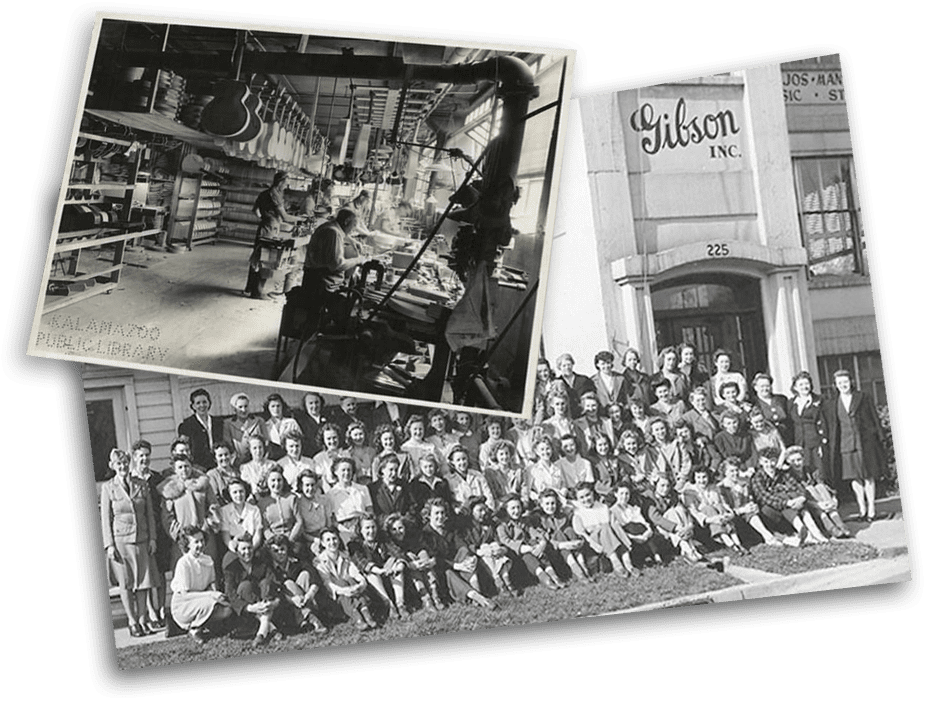
Gibson Archtops
Orville Gibson is often credited with the invention of the archtop guitar. Based on his 1898 patent for a mandolin, the design was intended to enhance “power and tone” during an era where volume was the biggest influence on guitar innovation.
The original archtop models were hollow steel-stringed acoustic or semi acoustic guitars with full bodies, distinctive arched tops, simple dot inlays on the fingerboard, unbound f-holes, and a basic three-ply binding around its carved solid-spruce top. Even as Gibson started making guitars with the big center sound hole, they still designed arched tops for these instruments. These archtop acoustics had fully replaced the banjo as the primary instrument in jazz bands by the 1930s.
Gibson Flat-Tops
The first Gibson flat-top models were released around the 1910s and aimed primarily at servicemen toward the end of WWI. While archtops became Gibson’s flagship leaders, the flat-top guitar became a regular of the Gibson catalogue. Gibson set out to compete with C.F. Martin guitars in the flat-top market. And they provided their own contributions and innovations.
Over the following decades, Gibson put out some of the most iconic acoustic guitar models in guitar history – the massive cowboy SJ-200, the slope-shoulder dreadnaught J-45, and the flashy Hummingbird to name maybe the biggest.
The Steel-String Era
To accommodate their consumers who struggled financially during the Great Depression, Gibson released budget guitars known as their “Kalamazoo” models. Gibson produced these guitars under different brand names such as Recording King, Cromwell, Fascinator, and Kel Kroy. The main difference between these guitars and a “house brand” model was the absence of an adjustable truss rod and ladder bracing under the tops rather than the X-bracing on most Gibsons. While they invested in making cheaper guitars, they also continued to make high-end guitars all through the depression.
The Gibson L Series
The Gibson L-1 is famously seen in one of three known photos of the legendary bluesman Robert Johnson. This guitar featured a tighter grained two-piece spruce top and Honduran mahogany back. In 1930, Gibson revisited the aesthetic of this piece by squaring off the bottom to a more traditional shape as opposed to the previously “egg shaped” bottom commonly known as the Robert Johnson style. Gibson went on to iterate this design with the L-2, and the L-3 (with superior woods and accoutrements).
Nick Lucas
Partnering with artists to create models started with early acoustic instruments such as the Nick Lucas flat-top, introduced in 1927. The Nick Lucas Gibson was the first artist-endorsed model offered in the market. Some consider the Lucas variation of the L-1 model as the first good flat-top guitar as the deeper body allowed for a huge difference in tone among the small body options. Gibson advertised the piece as “an exceptional guitar for vocal accompaniment on the stage, radio, and records.”
The Gibson Jumbo
With the release of the 16-inch wide, slope-shouldered Jumbo, Gibson set a template for its own Dreadnought that could directly compete with their top competitor: Martin. The original model was produced in sunburst finish with a mahogany back, a bound back and top, a rectangular bridge, a 3.75 inch sound hole, a pearl Gibson logo, a fire designed celluloid pickguard, and a rosewood fingerboard with dot inlays. Since its debut, Gibson dreadnought designs have been a mainstay of the flat-top world.
The SJ-200: The Gibson Super Jumbo
When cowboy star Ray Whitley ordered a custom acoustic guitar from Gibson in 1937, the most impressive flat-top model of the era was created. Also known as The Super Jumbo, the J-200 was named for its super-large 16 7/8″ flat top body, with a double-braced red spruce top, rosewood back and sides, and sunburst finish. This extra-large body allowed for a massive, expressive sound that had never been achieved on an acoustic guitar. It provides a deep low-end, slight mid-dip, and crisp high tones that are great for “full chord” music. In fact, the sound is so well balanced that it’s a favorite of engineers across the globe, who often refer to it as the “no EQ needed acoustic.” It was intended as the new top-of-the-line acoustic model for Gibson and remains a status symbol for players in the Country and Western circuits. With a reputation for being a countryman’s guitar, the J-200 is big, bold, and beautiful with curves aimed to kill.
Ryan Lockhart on a 2012 Gibson SJ-200.
Classical Gibson: The GS-85
Gibson started production of a flat-top classical guitar called the GS-85 in 1938. They only made sixty of these guitars. Twenty-seven Gibson GS-85s were made with Indian Rosewood back and sides. And thirty-three GS-85s were made with Mahogany back and sides. Gibson discontinued the model in 1942.
“Banner Era” Guitars
Due to record-keeping issues and construction inconsistencies, the stories of the Kalamazoo Girls are just reaching the surface of music history. Women were primarily in charge of guitar construction during WWII. Because of their dexterity in other detail-oriented fields, they were responsible for some of the finest flat-tops ever made. They created functional works of art that became known as “banner guitars” with delicate hand scalloping of the braces. Wartime production restrictions and materials shortages forced Gibson to reduce their flat-top models down to only six standard models: J-45, J-50, Southerner Jumbo, LG-1, LG-2 and LG-3. Banner guitars vary wildly in materials and construction techniques. Two consistent features that escaped this period are the golden banner stating that “Only A Gibson Is Good Enough” and great sound. These guitars were well-made, high resonant guitars on the whole. Because of the selective production during the war, banner guitars are considered the most collectible of the production years.
The LG Small Bodies
The LG series was introduced in 1942 and gradually replaced the earlier L series. These models differed from earlier Gibson small-bodies with their slightly wider waist and upper bout, giving them an outline similar to a classical guitar. They were made with a small neck that made them comfortable to play. The LG series provided adequate action and a full tone with a deep-quality bass sound traditionally made from more expensive guitars.
The LG-0 and LG-1 models were made with ladder bracing that gives a slightly different style of sound that some might consider more suited to blues and finger picking. The LG-2 and LG-3 models were made with X bracing which produced more sustain and is great for the chord rhythm playing style. The LG series embodies the old-time Delta blues tones of their predecessors, and now a days can be heard on many an alt-country and indy-songwriter recording, as well.
Gibson J-45 (The Workhorse)
The J-45 was officially introduced during wartime in 1942.This Gibson “workhorse” acoustic has been considered the instrument of choice for many notable guitarists such as Lightnin’ Hopkins, Buddy Holly, David Gilmour and Elliott Smith. The original models were instantly recognized by their ‘firestripe’ celluloid teardrop pickguard that became their standard tortoiseshell celluloid by 1943. In 1955, the teardrop became a more elongated profile extending along the treble side of the fretboard and featuring a point facing outwards towards the upper treble bout.
Around the same time, an additional (20th) fret was added to the J-45’s no-frills rosewood/mother-of-pearl dot inlay fingerboard. This model was considered an improvement upon its earlier models with a strengthened binding and large, C-shaped neck that could fill the hands. It is generally regarded as Gibson’s most famous and widely used acoustic guitar model. Evidently, Gibson was making provisions for the hard times ahead, and yet despite such austerity the company managed to produce an acoustic guitar that was not only a success at the time but has since become recognized as one of its most iconic designs.
The J-45 continued its success into the 1960s. After the success of the Hummingbird, Gibson squared off the shoulders of the J-45 – taking it away from its iconic design. They also introduced an adjustable bridge, which is an innovation for controlling action and intonation for sure. Eventually, Gibson went back to the original slope-shoulder design and a fixed bridge. One of the toughest bones in Gibson’s strong back, the J-45 is as loved today as it was upon introduction.
Perry Fowler of Sinners and Saints on a 1959 Gibson J-45.
The Gibson Square-Shoulder Dreadnought
The 1960s saw a rise in square-shoulder dreadnought releases. The first square-shoulder dreadnought released by Gibson was the Hummingbird in 1960. The success of the Hummingbird later influenced the most significant change to Gibson dreadnoughts: the production of the J-45 with a square-shoulder design between 1962 and 1969. Alongside the square J-45, a blend between the J-200 and the Hummingbird was released the same year as the Gibson Dove model. These models were considered echoes and improvements upon the C.F. Martin dreadnoughts as the debate became more heated about the impact of shoulder cuts. The wild success of these models have kept them in production since their releases.
The success of the Hummingbird later influenced the most significant change to Gibson dreadnoughts (as mentioned above): the production of the J-45 with a square-shoulder design between 1962 and 1969. Alongside the square J-45, a blend between the J-200 and the Hummingbird was released the same year as the Gibson Dove model.
Jason Poore on a 1976 Gibson Hummingbird Natural.
The Gibson Hummingbird
The first square-shoulder dreadnought released by Gibson was the Hummingbird in 1960. The Hummingbird had a bold pick guard design and a vibrant cherry paint burst finish. It also came in natural, but still brandished the elaborate pick guard. This was Gibson’s introduction into the square shoulder design. These were Gibson’s response and innovations on the C.F. Martin dreadnoughts as the debate became more heated about the impact of shoulder cuts. The Hummingbird came into that debate with bell-bottoms, long-hair, a tall collar, and a cowboy hat. It was definitely not understated.
The first wave of Hummingbirds came with a solid Sitka spruce top and solid mahogany back. The sides are mahogany, but not all of them are solid, many are laminated. They have adjustable rosewood or ceramic saddles, three-ply maple bridge plates, single X-bracing, engraved hummingbird-butterfly trumpet-flower pickguards with two points on the upper treble bout and one point level with the bridge, as well as bound fretboards with double parallelogram inlays, a crown peghead inlay on the headstock, golden green button tulip tuners, and a cherry burst (a.k.a. cherry sunburst) finish.
The Hummingbird “was and is” an eye catcher and plays exceptionally well with a rich tone that opened and paved the way for other household named flat-top Gibson acoustic guitars with square shoulders such as the Dove custom guitar, Country Western, and the Gibson Heritage.
The Gibson Dove
The Dove was Gibson’s second square-shouldered dreadnought after the Hummingbird, first manufactured in 1962 in Kalamazoo, MI. As opposed to the solid mahogany used for the Hummingbird, the dove utilizes maple for the back and sides of the guitar. This gives the Dove a louder sound and brighter tone. The Dove has a number of unique visual details, such as the double parallelogram fingerboard inlays, two doves on the bridge, and a dove on the pickguard (all of which are made of mother-of-pearl).
The original batch of Doves had Gibson’s metal tune-o-matic bridge, which was a technological improvement to the Hummingbird but had a slightly negative affect on tone and volume. The first run of Doves also had weak internal bracing, but that was improved in 1968, when Gibson made the bracing a good bit sturdier. These guitars are looked back on as a beautiful piece of history that remain very playable to this day and always make a visual statement.



